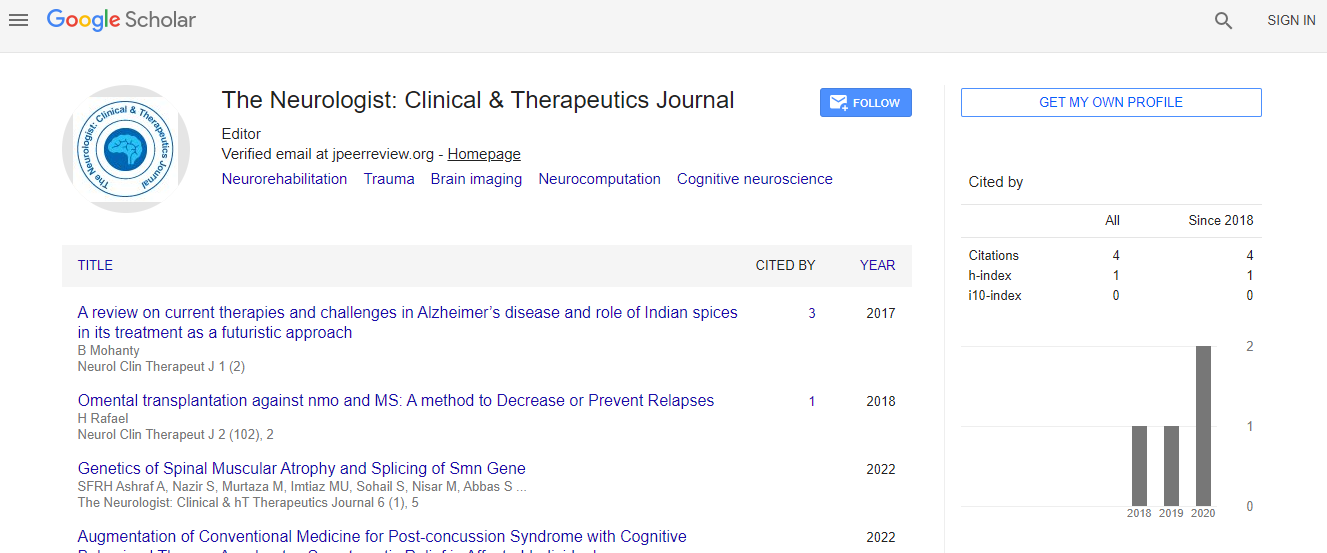Neuroscience-2019 & Neurologists 2019: Sensory modulation in peripheral and central lesions of somoto sensory system - AV Srinivasan - The Tamil Nadu Dr. M.G.R Medical University
*Corresponding Author: Aoun J, St. Elizabeth’s Medical Center, Tufts University School of Medicine, 736 Cambridge Street, Brighton, MA 02135, Massachusetts, USA, Tel: 617-789-3000, Email: joe.aoun@steward.orgReceived Date: Jul 02, 2018 / Accepted Date: Jul 17, 2018 / Published Date: Jul 24, 2018
Citation: Aoun J, Diaz-Cruz C, Dossett J, Dgayli K, Bedi H (2019) A Neurological Presentation of a Retroperitoneal Hemorrhage after a Cardiovascular Procedure. Neurologist Clin Ther 2: 109.
Copyright: © 2019 Aoun J, et al. This is an open-access article distributed under the terms of the Creative Commons Attribution License, which permits unrestricted use, distribution, and reproduction in any medium, provided the original author and source are credited.
Abstract
VS Ramachandran and AV Srinivasan et al (1998) described allesthesia and extinction of referred sensations in brachial plus lesions. K. Sathian et al (2000) suggested that intermanual referral of sensations can occur after central lesions of the Somato sensory system. This communication considers eight patients with five central lesions and three peripheral lesions of the Somato sensory system. Sensory modulation disorder (SMD) affects sensory processing across single or multiple sensory systems. The sensory over-responsivity (SOR) subtype of SMD is manifested clinically as a condition in which non-painful stimuli are perceived as abnormally irritating, unpleasant, or even painful. Moreover, SOR interferes with participation in daily routines and activities (Dunn, 2007; Bar-Shalita et al., 2008; Chien et al., 2016), co-occurs with daily pain hyper-sensitivity, and reduces quality of life due to bodily pain. Laboratory behavioral studies have confirmed abnormal pain perception, as demonstrated by hyperalgesia and an enhanced lingering painful sensation, in children and adults with SMD. Advanced quantitative sensory testing (QST) has revealed the mechanisms of altered pain processing in SOR whereby despite the existence of normal peripheral sensory processing, there is enhanced facilitation of pain-transmitting pathways along with preserved but delayed inhibitory pain modulation. These findings point to central nervous system (CNS) involvement as the underlying mechanism of pain hypersensitivity in SOR. Based on the mutual central processing of both non-painful and painful sensory stimuli, we suggest shared mechanisms such as cortical hyper-excitation, an excitatory-inhibitory neuronal imbalance, and sensory modulation alterations. This is supported by novel findings indicating that SOR is a risk factor and comorbidity of chronic non-neuropathic pain disorders. This is the first review to summarize current empirical knowledge investigating SMD and pain, a sensory modality not yet part of the official SMD realm. We propose a neurophysiological mechanism-based model for the interrelation between pain and SMD. Embracing the pain domain could significantly contribute to the understanding of this condition’s pathogenesis and how it manifests in daily life, as well as suggesting the basis for future potential mechanism-based therapies.
Methodology & Theoretical Orientation: Ecological model of sensory modulations has external and internal dimensions. This refers both physiological and behavioural responses. Disfunction in sensory integration is the ability, modulate, discriminate, co-ordinate or organise sensation adaptively. Eight patients aged between 19-51 with brachial plexus lesion one, amputation 2 patients, hemiparesis with hemisensory deficit five patients were analysed. Patients vibration and kinesthesis were tested. Stimuli were applied manually. All patients had Magnetic Resonance Imaging of the Brain and ENMG studies.
Findings: Central lesions: All the five stroke patients showed intermanual referral of sensations between 3rd and 4th month after developing hemisensory deficit. Three had thalamic stroke and two patients has temparoparietal infarct. Intermanual referred sensations to the affected hand in these patients were not referred to the affected leg. Intermanual referred sensations were poorly localised and the facial sensations were referred with increased intensity in the thalamic patients. When applied pressure on the normal hand resulted in the extinction of pain sensation side and pain recurred within one minute of the pressure being relieved. Peripheral Lesions: Amputation of Limbs: Both the patients (below elbow and knee amputation) showed intermanual referral sensation within ten days. The referred sensation of touch and vibration lacked spatial organisation and poor localization with a relatively high threshold. Brachial Plexus Lesion: Patient had sensation intermanually referred in a topographically organised manner in the phantom limb. Intriguingly, simultaneous stimulation of the specific region (e.g. thumb) of the face and the corresponding finger of the right hand resulted in a mutual cancellation or extinction of the referred sensations in the phantom limb.
Conclusions & Significance: 1.0 Intermanual referral of the sensations in the phantom limb occurred immediately in Brachial plexus lesion and amputation, whereas it occurred after a delay of three month is in hemiparesis with hemisensory deficit. This can be utilised for extinction of pain in the paretic side and in the Phantom limb. 2.0 Sensations were referred intermanually in a topographically organized manner in Brachial Plexus lesions, whereas in amputations and hemiparesis with hemisensory deficit, lacked spatial and poor localization. Disclosure: Dr. Venkatesan has nothing to disclose.

 Spanish
Spanish  Chinese
Chinese  Russian
Russian  German
German  French
French  Japanese
Japanese  Portuguese
Portuguese  Hindi
Hindi 